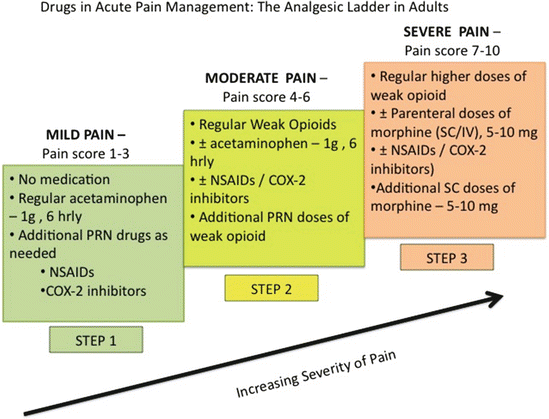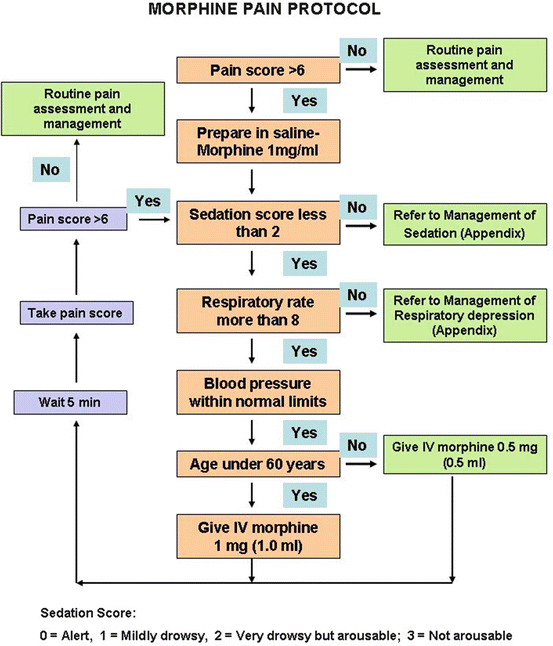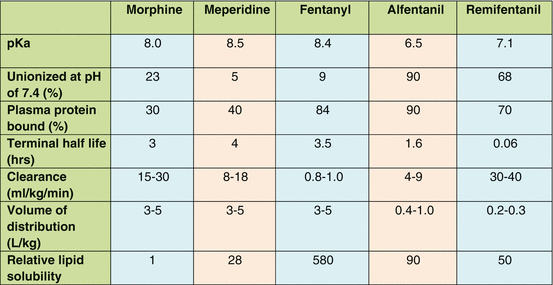Fig. 18.1
The pain pathway and sites of action of analgesic drugs
Non-steroidal anti-inflammatory drugs (NSAIDS) and local anesthetics (LA) are effective at the periphery where transduction of pain signals arise
Local anesthetics are effective in controlling pain all along the afferent axons conducting pain signals until it enters the spinal cord at the dorsal horn. In addition ketamine and α-2 agonists act on transmission at the spinal cord level.
Tramadol and tricyclic antidepressants (TCA) act on modulating mechanisms.
Opioids act on the opioid receptors in the brain altering the perception of pain as well on the opioid receptors in the dorsal horn of the spinal cord by inhibiting or reducing the onward transmission of pain signals.
Pharmacological Management
First Line of Management
The use of analgesic medications is the first line of treatment. The drugs and choice of route that one uses depends on the severity of pain. Use the Analgesic ladder to choose appropriate drugs (Fig. 18.2).


Fig. 18.2
The analgesic ladder
For example, when a patient is in severe pain (pain score >7/10) the choice of analgesic is an opioid, which should be administered via the intravenous route. The choice of opioid is either morphine or fentanyl.
Intravenous Opioid Administration
Morphine is available in an ampoule in a concentration of 10 mg/ml. It should be diluted in a 10 ml syringe with water/normal saline to a concentration of 1 mg/ml. Rapid relief can be achieved by providing small bolus doses of morphine (0.5–1.0 mg) until the patient is comfortable, i.e. the opioid is titrated until pain relief is achieved. There is a wide range in individual analgesic requirements hence this technique provides pain relief adequate to the needs of a patient. Direct intravenous administration bypasses the need for the drug to be absorbed into the systemic circulation either from the subcutaneous tissues (if administered by subcutaneous route) or from the gut (if given orally). It is also immediately available to cross the blood-brain barrier to act on the opioid receptors in the brain.
By giving small bolus doses and waiting for 3–4 min between doses, you can rapidly control severe pain while not causing sedation or respiratory depression. The morphine pain protocol is a useful guide for a beginner (Fig. 18.3).


Fig. 18.3
Morphine pain protocol
Mechanism of Action of Opioids
Opioids belong to a family of drugs that act on the opioid receptors in the brain and spinal cord to provide analgesia. Opioid receptors were discovered in the 1970s and we currently know that there are three main types of opioid receptors (μ, κ, δ). In the brain they are found in the regions of the sensory cortex, anterior cingular cortex (ACC), insula, periaqueductal gray (PAG) in the midbrain and rostral ventromedial medulla (RVM). In the spinal cord they are found at both the pre-synaptic and post-synaptic regions of dorsal horn neurons.
Opioids are agonists and act via the inhibitory G-proteins of the opioid receptors. Opioids modulate and reduce incoming ascending pain signals traveling to the brain and also activate descending inhibitory pathways, which travel from the midbrain to the spinal cord.
The μ receptor is the main receptor that all the potent opioids act on. Opioids are classified as weak and strong opioids depending on their binding affinity to the μ receptor.
Weak opioids are tramadol and codeine. Tramadol is also known as an atypical opioid as it has a dual mechanism of action. Codeine is a pro-drug, which has to be metabolized in the liver to morphine for its analgesic action. Hence codeine has no analgesic action in patients who cannot metabolize the drug.
Strong or potent opioids used commonly for the relief of severe pain are:
Morphine, pethidine, fentanyl, oxycodone – available for parenteral use (IV/SC)
Morphine and oxycodone are also available in the oral form; both as immediate-release formulations, i.e. aqueous morphine and immediate-release oxycodone capsules (Oxynorm®), and slow/sustained-release tablets, i.e. morphine sulfate (MS Contin®) and oxycodone (Oxycontin®).
Morphine is considered as the gold standard and all other opioids are compared to it, both in terms of potency and lipophilicity.
Pharmacokinetics of Opioids
Table 18.1 shows the pharmacokinetic data of various opioids, which helps us to understand the speed and duration of action, elimination characteristics and the rationale for their use in different situations.

Table 18.1
Pharmacokinetics of commonly used opioids

Alfentanil and remifentanil are short-acting opioids that are mainly used by anesthesiologists during surgery. The rapidity of onset of analgesia depends on the percentage of unionized drug in the plasma on intravenous administration. Both drugs have a pKa below the pH of plasma – 7.4, hence highly unionized (90 % and 68 %) and can cross the blood-brain barrier rapidly to produce its analgesic effect. The volume of distribution is also small compared to the other three opioids so they are rapidly eliminated from the plasma accounting for their short duration of action. They are not suitable opioids for use in the wards or in the emergency & accident unit.
Fentanyl is more rapid in onset compared to morphine; although only 9 % of the drug is unionized in the plasma it penetrates the blood brain barrier more rapidly because of high lipid solubility (see Table 18.1). Fentanyl is available in a 2 ml glass ampoule at a concentration of 50 μg/ml. It should be diluted with water or normal saline in a 10 ml syringe, and boluses of 20 μg of fentanyl should be given intravenously until the patient is more comfortable and the pain score is less than 4/10. There should be at least 3 min between doses.
However, the duration of action of morphine is longer than fentanyl, although the volume of distribution is the same as fentanyl. This is because morphine has the least lipid solubility of all the commonly used opioids. It is cleared less rapidly from the CNS.
Continuation of Analgesia
When severe acute pain has been controlled following an injury, a patient will need ongoing analgesia until a definitive diagnosis is made and appropriate management is undertaken. This plan of action depends on the cause of the onset of acute pain, which can be trauma, acute abdomen or any other painful medical condition. The analgesic regime can include either starting the patient on intravenous patient controlled analgesia (PCA) with morphine or regular doses of subcutaneous (SC) morphine. This can range from 5 to 10 mg, 4–6 hourly.
The dose of morphine that is needed depends on the response of the patient as the analgesic requirement varies individually. The initial dose that one starts with depends on the age of the patient rather than the weight in adult patients. You should start with small doses (5 mg) in older patients.
All opioids are associated with side effects. Around 30 % of patients have nausea/vomiting with opioids as the chemoreceptor trigger zone in the midbrain is close to opioid receptors. Pain score and sedation should be monitored regularly and the subsequent dose of morphine should be omitted if the patient becomes drowsy and difficult to arouse. Sedation is an early indicator of impending respiratory depression. (See Appendix for management of nausea/vomiting, sedation and respiratory depression)
Stay updated, free articles. Join our Telegram channel

Full access? Get Clinical Tree


